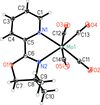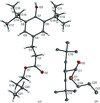issue contents
February 2019 issue

Cover illustration: In the structure of (methanol-![[kappa]](/logos/entities/kappa_rmgif.gif) O)bis(thiocyanato-
O)bis(thiocyanato-![[kappa]](/logos/entities/kappa_rmgif.gif) N)[2,4,6-tris(pyridin-2-yl)-1,3,5-triazine-
N)[2,4,6-tris(pyridin-2-yl)-1,3,5-triazine-![[kappa]](/logos/entities/kappa_rmgif.gif) 3N2,N1,N6]nickel(II) methanol monosolvate, [Ni(NCS)2(C18H12N6)(CH3OH)]·CH3OH, the NiII ion is six-coordinated in an octahedral coordination environment defined by three N atoms from a 2,4,6-tris(pyridin-2-yl)-1,3,5-triazine ligand, two N atoms from two mutually cis-positioned SCN- anions and one O atom from a methanol ligand. The complex and methanol solvent molecules are linked by intermolecular hydrogen bonds. In the crystal, the complex molecules are stacked in columns parallel to the b axis. See: Ha [IUCrData (2019). 4, x190169].
3N2,N1,N6]nickel(II) methanol monosolvate, [Ni(NCS)2(C18H12N6)(CH3OH)]·CH3OH, the NiII ion is six-coordinated in an octahedral coordination environment defined by three N atoms from a 2,4,6-tris(pyridin-2-yl)-1,3,5-triazine ligand, two N atoms from two mutually cis-positioned SCN- anions and one O atom from a methanol ligand. The complex and methanol solvent molecules are linked by intermolecular hydrogen bonds. In the crystal, the complex molecules are stacked in columns parallel to the b axis. See: Ha [IUCrData (2019). 4, x190169].
metal-organic compounds


 access
access

 access
access

 access
access

 access
accessorganic compounds


 access
access

 access
access

 access
access

 access
access

 access
access

 access
access

 access
access

 access
access

 access
access

 access
access

 access
access

 access
access

 access
access

 access
access

 journal menu
journal menu





























![[publCIF]](/logos/authorchecklist11.gif)





